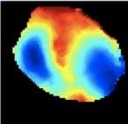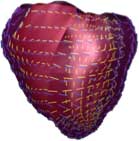The main research areas being pursued include cardiac development, cardiac hypertrophy, heart failure, cardiac ischemia and hypoxia, and cardiac regeneration. A unique feature of the interdisciplinary research and clinical translation being carried out at CBSEC is the use and development of state-‐of-‐the-‐art bioengineering technologies in combination with sophisticated cellular and molecular biological approaches. Bioengineering technologies include biomechanics, tissue engineering, biomaterials, biomedical imaging, biophotonics, and systems biology and multi-‐scale modeling. Cellular and molecular biologic approaches will include investigation of cardiac regeneration from cell culture to the intact heart and use of genetically engineered models to study cardiac diseases.

Optical mapping of electrical activation on the heart surface. Blue: Early. Red: Late.
The CBSEC leverages on the strong program on cardiac mechanics in UCSD to investigate the regional mechanics of the cardiac ventricle in relation to heart diseases and tissue remodeling. The interplay between mechanics and electrical activity, which are especially important in heart failure and arrhythmias, will be studied by combining in-vitro, in-vivo and in-silico approaches. The molecular basis of normal and pathological structure/function of the heart are being elucidated with high-‐resolution medical imaging and biophotonics, in combination with genetic and molecular approaches to develop novel, molecular models of cardiac disease. The cellular and molecular responses to mechanical forces are studied in normal and failing hearts. Systems biology approaches are used to integrate the complex biomedical findings through network construction, computer modeling, hypothesis generation, and experimentation. Computation modeling and analysis are applied to bedside to improve clinical management of heart diseases.
 Stem cells and biomaterials have great potential for regenerative medicine therapy to restore, maintain, and/or enhance tissue and organ functions. Particular emphasis is being placed on the role of the microenvironment of the myocardial cells in combination with manipulation of the signaling cues that are important for cardiac regeneration. These approaches include understanding of the chemical and mechanical properties of the cell matrix, in the differentiation of stem cells for use in regenerating injured and diseased cardiovascular tissue.
Stem cells and biomaterials have great potential for regenerative medicine therapy to restore, maintain, and/or enhance tissue and organ functions. Particular emphasis is being placed on the role of the microenvironment of the myocardial cells in combination with manipulation of the signaling cues that are important for cardiac regeneration. These approaches include understanding of the chemical and mechanical properties of the cell matrix, in the differentiation of stem cells for use in regenerating injured and diseased cardiovascular tissue.
These interdisciplinary research collaborations is closely connected to the training of the next-‐generation of physicians and scientists, the enhancement of academia-‐industry interactions, and the translation of research findings to clinical medicine, in collaboration with the Sulpizio Family Cardiovascular Center. The ultimate goals are to benefit patients suffering from heart diseases and improve human health and wellbeing.
Computational modeling to improve diagnosis and treatment of heart failure and rhythm disorders.

 The Cardiac Biomedical Science and Engineering Center (CBSEC) was established in the IEM in September, 2009. The mission of the CBSEC is to synergize the expertise in cardiac research and its translation in UCSD and neighboring institutions in La Jolla to combat heart diseases, which are the leading cause of morbidity and mortality. The CBSEC brings together scientists and students at the Jacobs School of Engineering, UCSD Health Sciences, neighboring institutions and industry partners to:
The Cardiac Biomedical Science and Engineering Center (CBSEC) was established in the IEM in September, 2009. The mission of the CBSEC is to synergize the expertise in cardiac research and its translation in UCSD and neighboring institutions in La Jolla to combat heart diseases, which are the leading cause of morbidity and mortality. The CBSEC brings together scientists and students at the Jacobs School of Engineering, UCSD Health Sciences, neighboring institutions and industry partners to: Optical mapping of electrical activation on the heart surface. Blue: Early. Red: Late.
Optical mapping of electrical activation on the heart surface. Blue: Early. Red: Late. Stem cells and biomaterials have great potential for regenerative medicine therapy to restore, maintain, and/or enhance tissue and organ functions. Particular emphasis is being placed on the role of the microenvironment of the myocardial cells in combination with manipulation of the signaling cues that are important for cardiac regeneration. These approaches include understanding of the chemical and mechanical properties of the cell matrix, in the differentiation of stem cells for use in regenerating injured and diseased cardiovascular tissue.
Stem cells and biomaterials have great potential for regenerative medicine therapy to restore, maintain, and/or enhance tissue and organ functions. Particular emphasis is being placed on the role of the microenvironment of the myocardial cells in combination with manipulation of the signaling cues that are important for cardiac regeneration. These approaches include understanding of the chemical and mechanical properties of the cell matrix, in the differentiation of stem cells for use in regenerating injured and diseased cardiovascular tissue.